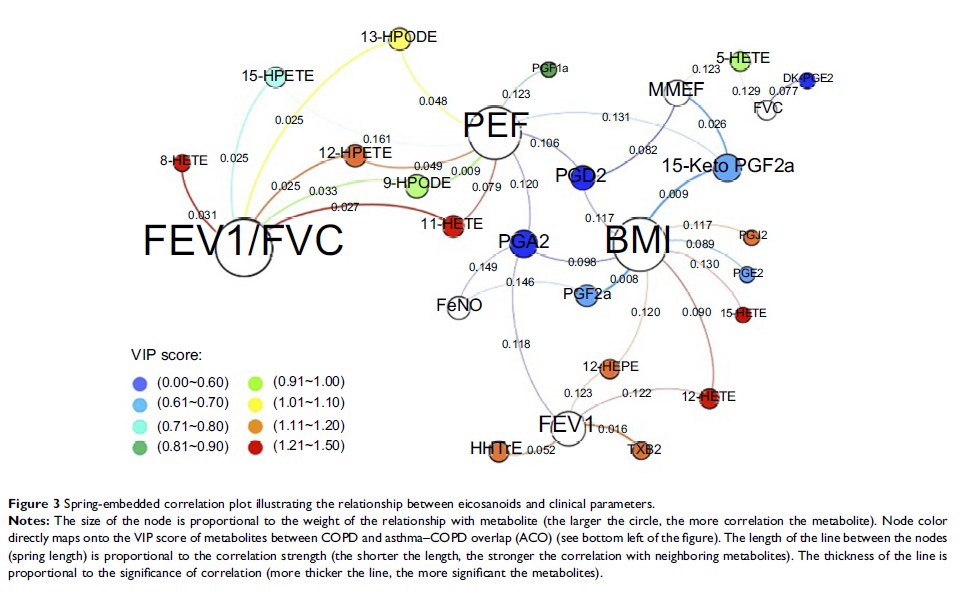9 0 6 7 6
论文已发表
注册即可获取德孚的最新动态
IF 收录期刊
- 2.6 Breast Cancer (Dove Med Press)
- 3.9 Clin Epidemiol
- 3.3 Cancer Manag Res
- 3.9 Infect Drug Resist
- 3.6 Clin Interv Aging
- 4.8 Drug Des Dev Ther
- 2.8 Int J Chronic Obstr
- 8.0 Int J Nanomed
- 2.3 Int J Women's Health
- 3.2 Neuropsych Dis Treat
- 4.0 OncoTargets Ther
- 2.2 Patient Prefer Adher
- 2.8 Ther Clin Risk Manag
- 2.7 J Pain Res
- 3.3 Diabet Metab Synd Ob
- 4.3 Psychol Res Behav Ma
- 3.4 Nat Sci Sleep
- 1.9 Pharmgenomics Pers Med
- 3.5 Risk Manag Healthc Policy
- 4.5 J Inflamm Res
- 2.3 Int J Gen Med
- 4.1 J Hepatocell Carcinoma
- 3.2 J Asthma Allergy
- 2.3 Clin Cosmet Investig Dermatol
- 3.3 J Multidiscip Healthc

代谢组学研究表明,类花生酸经由 LOX 代谢可区分哮喘 - COPD 的重叠与 COPD
Authors Cai C, Bian X, Xue M, Liu X, Hu H, Wang J, Zheng SG, Sun B, Wu JL
Received 27 February 2019
Accepted for publication 24 May 2019
Published 6 August 2019 Volume 2019:14 Pages 1769—1778
DOI https://doi.org/10.2147/COPD.S207023
Checked for plagiarism Yes
Review by Single-blind
Peer reviewers approved by Dr Amy Norman
Peer reviewer comments 2
Editor who approved publication: Prof. Dr. Chunxue Bai
Background and objective: The prevalence of asthma is greater than 20% in patients previously diagnosed with COPD. Patients with asthma–COPD overlap (ACO) are at risk of rapid progression of disease and severe exacerbations. However, in some patients with ACO, a clear distinction from COPD is very difficult by using physiological testing techniques. This study aimed to apply a novel metabolomic approach to identify the metabolites in sera in order to distinguish ACO from COPD.
Methods: In the study, blood samples were collected from patients with COPD, ACO, and healthy controls. Cholamine derivatization-ultrahigh performance liquid chromatography-quadrupole time-of-flight mass spectrometry (UHPLC-Q-TOF/MS) was used to investigate serum metabolites of eicosanoids.
Results: A clear intergroup separation existed between the patients with ACO and those with COPD, while ACO tends to have higher serum metabolic levels of eicosanoids. A robust Orthogonal Projections to Latent Structures-Discriminant Analysis (OPLS-DA) model was found for discriminating between ACO and COPD (R2Y =0.81, Q2=0.79). In addition, there is a significant correlation between some metabolites and clinical indicators, such as hydroxyeicosatetraenoic acids (HETEs), hydroperoxyeicosatetraenoic acids (HPETEs) and FEV1/FVC. The higher values of area under the receiver operating characteristic curves (ROC) of HETEs, which were metabolized from HPETEs through lipoxygenase (LOX), indicated that they should be the potential biomarkers to distinguish ACO from COPD.
Conclusion: Eicosanoids can clearly discriminate different biochemical metabolic profiles between ACO and COPD. The results possibly provide a new perspective to identify potential biomarkers of ACO and may be helpful for personalized treatment.
Keywords: metabolomics, COPD, asthma–COPD overlap, cholamine derivatization-UHPLC-Q-TOF/MS
